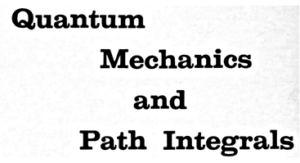\(\)

Problem 6-15
Recall that in Prob. 5-4 we defined a particular integral as the transition amplitude to go from state \( \psi(x) \) to state \( \chi(x) \). Show that the function \( \lambda_{m n} \) satisfies this definition when the initial state is the eigenfunction \( \phi_{n}(x) \) and the final state is the eigenfunction \( \phi_{m}(x) \).
(解答例) 問題 5-4 では, 次の積分を状態 \( \psi(x) \) から \( \chi(x) \) への「遷移振幅」と呼んだ:
\begin{equation}
\def\mb#1{\mathbf{#1}}
\def\BraKet#1#2#3{\langle #1|#2|#3\rangle}
\BraKet{\chi}{1}{\psi}=\int_{-\infty}^{\infty} dx_{1}\int_{-\infty}^{\infty} dx_{2}\,
\chi^{*}(x_{2})\,K(x_{2},t_{2};x_{1},t_{1})\,\psi(x_{1})
\tag{1}
\end{equation}
\def\mb#1{\mathbf{#1}}
\def\BraKet#1#2#3{\langle #1|#2|#3\rangle}
\BraKet{\chi}{1}{\psi}=\int_{-\infty}^{\infty} dx_{1}\int_{-\infty}^{\infty} dx_{2}\,
\chi^{*}(x_{2})\,K(x_{2},t_{2};x_{1},t_{1})\,\psi(x_{1})
\tag{1}
\end{equation}
この量は \(x_{1}\) と \(x_{2}\) で積分されており, 変数 \(t_{1},t_{2}\) だけに依存することに注意する. このとき, 核 \(K\) に「遷移振幅 \(\lambda_{m n}\) を定義する式」である式 (6-68) の \(K_{V}\) を用いる:
\begin{equation}
K\rightarrow K_{V}(2,1)=\sum_{n}\sum_{m} \lambda_{m n}(t_{2},t_{1})\,\phi_{m}(x_{2})\,\phi^{*}_{n}(x_{1})
\tag{2}
\end{equation}
K\rightarrow K_{V}(2,1)=\sum_{n}\sum_{m} \lambda_{m n}(t_{2},t_{1})\,\phi_{m}(x_{2})\,\phi^{*}_{n}(x_{1})
\tag{2}
\end{equation}
そして初期状態を \(\psi(x)=\phi_{i}^{*}(x)\) , また, 終状態を \(\chi(x)=\phi_{j}(x)\) とする. 以上のことを式 (1) に代入する. すると \(\phi_{i}(x)\) の「規格直交性」を用いることで次となる:
\begin{align}
\BraKet{\chi}{1}{\psi}&=\int_{-\infty}^{\infty} dx_{1}
\int_{-\infty}^{\infty} dx_{2}\,\chi^{*}(x_{2})\,K_{V}(2,1)\,\psi(x_{1})\notag\\
&=\int_{-\infty}^{\infty} dx_{1}\int_{-\infty}^{\infty} dx_{2}\,\phi_{j}^{*}(x_{2})\,\sum_{n}\sum_{m}
\lambda_{m n}\phi_{m}(x_{2})\phi_{n}(x_{1})\phi_{i}^{*}(x_{1})\notag\\
&=\sum_{n}\sum_{m} \lambda_{m n}\int_{-\infty}^{\infty} dx_{1}\,\phi_{n}(x_{1})\phi_{i}^{*}(x_{1})
\int_{-\infty}^{\infty} dx_{2}\,\phi_{j}^{*}(x_{2})\,\phi_{m}(x_{2})\notag\\
&=\sum_{n}\sum_{m} \lambda_{m n}\delta_{n i}\delta_{j m}=\lambda_{i j}
\tag{3}
\end{align}
\BraKet{\chi}{1}{\psi}&=\int_{-\infty}^{\infty} dx_{1}
\int_{-\infty}^{\infty} dx_{2}\,\chi^{*}(x_{2})\,K_{V}(2,1)\,\psi(x_{1})\notag\\
&=\int_{-\infty}^{\infty} dx_{1}\int_{-\infty}^{\infty} dx_{2}\,\phi_{j}^{*}(x_{2})\,\sum_{n}\sum_{m}
\lambda_{m n}\phi_{m}(x_{2})\phi_{n}(x_{1})\phi_{i}^{*}(x_{1})\notag\\
&=\sum_{n}\sum_{m} \lambda_{m n}\int_{-\infty}^{\infty} dx_{1}\,\phi_{n}(x_{1})\phi_{i}^{*}(x_{1})
\int_{-\infty}^{\infty} dx_{2}\,\phi_{j}^{*}(x_{2})\,\phi_{m}(x_{2})\notag\\
&=\sum_{n}\sum_{m} \lambda_{m n}\delta_{n i}\delta_{j m}=\lambda_{i j}
\tag{3}
\end{align}
よって \(\lambda_{i j}\) の定義は「遷移振幅」 \(\BraKet{\chi}{1}{\psi}\) に一致している ことが示された.


